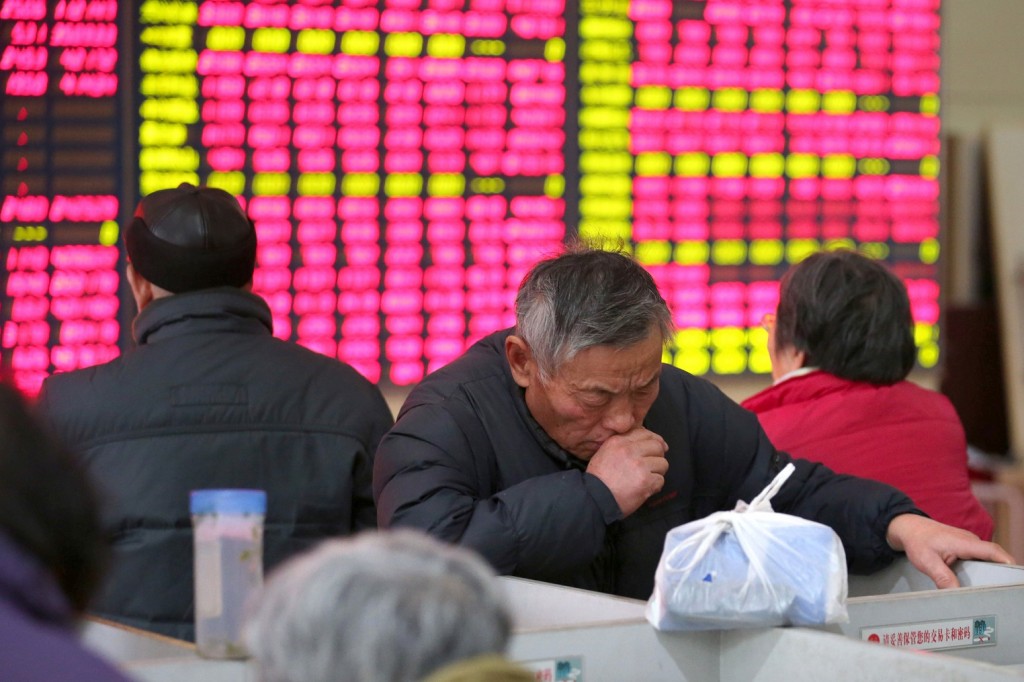- California Assembly OKs highest minimum wage in nation
- S. Korea unveils first graphic cigarette warnings
- US joins with South Korea, Japan in bid to deter North Korea
- LPGA golfer Chun In-gee finally back in action
- S. Korea won’t be top seed in final World Cup qualification round
- US men’s soccer misses 2nd straight Olympics
- US back on track in qualifying with 4-0 win over Guatemala
- High-intensity workout injuries spawn cottage industry
- CDC expands range of Zika mosquitoes into parts of Northeast
- Who knew? ‘The Walking Dead’ is helping families connect
World could face months of Chinese market aftershocks

A Chinese stock investor monitors stock prices at a brokerage house in Nantong in eastern China’s Jiangsu province Wednesday, Jan. 6, 2016. China plans to restrict stock sales by large shareholders once a ban imposed in July to stop a slide in prices is lifted this week. (Chinatopix via AP)
BEIJING (AP) — The latest trigger was currency jitters, but Thursday’s plunge in Chinese stocks was just one in a series of aftershocks from last year’s boom and bust that could shake markets for months to come.
Investor anxiety over economic weakness and a possible glut of unwanted shares flooding the market have complicated Beijing’s efforts to withdraw emergency controls imposed after Chinese stock prices collapsed in June.
On Thursday, trading halted for the day after a stock index fell 7 percent a half-hour into the trading day. It was this week’s second daylong suspension after a plunge in prices Monday tripped the same “circuit breakers” that were introduced Jan. 1.
The turmoil in China triggered a sell-off in Asian and Western stocks. Beijing keeps its markets sealed off from global capital flows, but due to the vast size of China’s economy, foreign investors watch them closely and react to volatility.
“The market still is trying to find a bottom, and that takes time,” said Chen Yong, a strategist at Lianxun Securities. “The key is to be able to resume normal daily trading, and during that time volatility is inevitable.”
The upheaval disrupted the ruling Communist Party’s plans to use the stock markets as a tool to make China’s state-dominated economy more competitive and productive.
Economic growth fell to a six-year low of 6.9 percent in the July-September quarter and is forecast by the International Monetary Fund to decline further to 6.3 percent this year. Monday’s stock price plunged was triggered by surveys that showed manufacturing in December was weaker than expected.
The latest bout of selling was fueled by concern Beijing is letting China’s yuan weaken too fast against the dollar.
The yuan, also known as the renminbi, has drifted down by 6 percent against the U.S. currency since the central bank adopted a mechanism in August it said would make the state-set exchange rate more market-oriented.
The yuan’s link to the dollar meant it soared as the U.S. currency climbed over the past year, making it overvalued by 10 to 15 percent against those of other developing countries. But the prospect Beijing would close such a large gap fueled fears it might lead to an outflow of capital, weakening China’s economy and reducing the supply of money to support share prices.
Thursday’s exchange rate of 6.5646 yuan to the dollar was the lowest since March 2011.
“The government hopes to see the yuan depreciate to stimulate exports and the economy, but the speed of depreciation went too fast,” said analyst Zhang Gang of Central China Securities.
The White House said the U.S. was closely monitoring China’s currency. White House spokesman Josh Earnest said the U.S. approach to the uncertainty was to continue pressing China to speed up the pace of economic reforms he said would benefit China long-term and help the global economy.
Investors also were skittish about the impending end Thursday of a six-month ban on share sales by any stockholder who owns more than 5 percent of a company, according to Zhang.
Regulators tried to head off such concern by announcing earlier in the week major shareholders could sell only in private transactions to avoid flooding the market. After Thursday’s market plunge, the securities agency tightened that restriction by saying they can unload only the equivalent of 1 percent of a company’s shares over the next three months.
“Additional volatility in China’s stock market remains almost certain in the first half of 2016,” said economist Brian Jackson of IHS Global Insight in a report. “China’s stock market reform will remain a messy affair.”
Chinese leaders encouraged novice investors to pile into stocks beginning in late 2014. They wanted to raise money for state companies to pay down heavy debt loads and become profit-oriented and competitive. Communist planners also hoped investing would help families save for retirement, easing the pressure on Beijing to pay for pensions and health care.
Those plans went wrong when markets soared faster than Beijing wanted. By May, state media that cheered on higher prices started to mix in appeals for investors to act prudently.
After prices plunged in June, the government banned sales by big shareholders, ordered state companies to buy stock, cut interest rates and canceled initial public offerings.
The government has yet to say what its intervention cost, but Goldman Sachs has estimated state entities spent 860 billion-900 billion yuan ($135 billion-$140 billion) to buy shares in June and July.
The “circuit breakers” might be adding to volatility instead of dampening it as similar measures do in Japan, Thailand and other Asian markets, economists said. They said the 5 percent gain or loss in the CSI 300 index that triggers a 15-minute trading suspension and the 7 percent margin that ends trading for the day might be too low a threshold.
According to IHS, the mechanism would have been tripped 20 times if it had been in place in the final quarter of 2015.
“It’s hard to see how the circuit breakers can remain in their current form,” said Bernard Aw, a market strategist at investment company IG in Singapore.
___
AP researchers Yu Bing in Beijing and Fu Ting in Shanghai and writer Josh Lederman in Washington contributed.
















